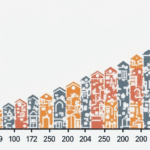Introduction
Over the past two and a half years, the use of generative artificial intelligence (Gen AI) applications has evolved from a technological curiosity to an integral part of the digital ecosystem. Andreessen Horowitz (a16z) has released its fifth edition of the Top 100 Gen AI Consumer Apps, serving as a benchmark to identify which applications have gained traction among users.
Mobile vs Web Rankings
The ranking consists of two separate lists: the Top 50 mobile Gen AI apps and the Top 50 web Gen AI apps. Mobile apps are evaluated based on their monthly active users (MAU) according to Sensor Tower data. Notably, apps that later added AI functionalities but were not originally designed for automatic generation are excluded.
New Entrants and Rearrangements
The report highlights that the Gen AI ecosystem is moving past its initial volatile stages. Only 11 new web apps and 14 new mobile apps entered the top 50 in this edition, compared to 17 web and 14 mobile newcomers in the March 2025 edition. Google successfully placed four new products on the web list by separating measurable domains for each, making their AI initiatives more visible.
Regional Participation and Exportation
While many international apps dominate the rankings, the report emphasizes China’s strong presence. Three Chinese web apps—Quark (Alibaba), Doubao (Bytedance), and Kimi (Moonshot AI)—are among the top 20 positions. Over 20 of the 50 mobile apps come from Chinese developers, though many cater to local markets. The report also notes that some apps are used globally despite being blocked in China, with seven companies having Chinese development but primarily used outside the country.
All Stars: Consistent Ranking Leaders
Since the first web ranking edition, 14 apps have consistently appeared in all editions. a16z classifies them as All Stars, covering various domains such as general assistants (ChatGPT, Perplexity, Poe), image generation (Midjourney, Leonardo), image/video editing (Veed, Cutout), voice (Eleven Labs), productivity (Photoroom, Quillbot), and model hosting (Hugging Face, Civitai). Five operate with proprietary base models, seven use APIs or open-source models, and two act as model aggregators.
Emerging Trends
- Integrated Multimodality. Leading apps no longer limit themselves to text, image, voice, or video. Instead, they aim for unified experiences, incorporating voice input, visual output, and simultaneous content generation. Gemini, for example, explores conversational interfaces with video.
- Vibe Coding. Platforms like Replit and Lovable enable users without deep programming skills to create functional AI-powered apps quickly. The report mentions that some users of these platforms maintain or even increase their spending months after registration.
- Personalization and Personal Copilot Apps. Alongside generalist assistants competing to be the default interface, a new generation of specialized apps emerges for sectors like design, education, healthcare, law, marketing, and audiovisual production. These apps tailor their AI models to specific domains, enhancing precision, relevance, and utility for end-users. Many also incorporate personalization layers, learning users’ styles, preferences, and habitual information sources.
- Revenue Retention through Consumption. In a complementary report, a16z describes how successful apps achieve revenue growth within their user cohorts. Instead of flat-rate subscriptions, many users increase spending as they use more features or consume credit. This phenomenon is called “Great Expansion,” where users consume more over time, multiplying income within the installed base.
Key Questions and Answers
- What is the purpose of a16z’s Top 100 Gen AI Consumer Apps ranking? The ranking identifies which Gen AI apps have gained traction among users, serving as a benchmark for the digital consumption landscape.
- How are mobile and web apps ranked differently? Mobile apps are evaluated based on monthly active users (MAU) according to Sensor Tower data, while web apps are ranked using similar metrics.
- Why are some popular AI-enhanced apps not included in the ranking? Apps that added AI functionalities later but were not originally designed for automatic generation are excluded.
- Which regions have a strong presence in the ranking? Despite international dominance, China has a significant presence with multiple apps in the top 20 web positions and over 20 mobile apps from Chinese developers.
- What are the emerging trends in Gen AI apps? Integrated multimodality, vibe coding, personalization and copilot apps, and revenue retention through consumption are key trends shaping the future of Gen AI apps.






